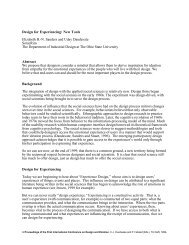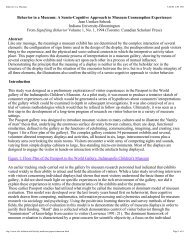: Interface as Content The Construction of Experience - ec(h)o
: Interface as Content The Construction of Experience - ec(h)o
: Interface as Content The Construction of Experience - ec(h)o
You also want an ePaper? Increase the reach of your titles
YUMPU automatically turns print PDFs into web optimized ePapers that Google loves.
David Rokeby : Transforming Mirrors3/11/03 4:21 PMthat understood movement, I’d evolved with the interface, developing a way <strong>of</strong> moving that theinterface understood <strong>as</strong> I developed the interface itself. I’d experienced a physiological version <strong>of</strong>the very convergence that Turing described.While we may lose our ability to understand and articulate the differences, we will still have someintuitive sense <strong>of</strong> them. But many <strong>of</strong> the differences between virtuality and reality will be subtle ande<strong>as</strong>y to discount, and intuition <strong>of</strong>ten loses in the face <strong>of</strong> hard logic; we may find it <strong>as</strong> e<strong>as</strong>y to ignoreour intuitions <strong>as</strong> to ignore our inner-ears while immersed in VR. I believe there are importantre<strong>as</strong>ons, beyond simply romantic nostalgia, to nurture awareness <strong>of</strong> the distinctions between thereal and the virtual.THE EXPERIENCE OF BEINGBy defining a way <strong>of</strong> sensing and a way <strong>of</strong> acting in an interactive system, the interface definesthe “experience <strong>of</strong> being” for that system. Through their design <strong>of</strong> the interface, the creators have inlarge part defined the user’s “quality <strong>of</strong> life” while they are interacting with the system. Unfortunately,the design parameters for quality <strong>of</strong> life are pretty undefined. <strong>The</strong>re seems to be no agreement onwhat makes for a high “quality <strong>of</strong> life.” I susp<strong>ec</strong>t it’s dependent on a whole range <strong>of</strong> parameters thatwe rarely pay attention to.In order to better understand what those parameters are, we need to look at how our experience<strong>of</strong> the real world is constructed. In other words, what is our user interface for reality? or: What is thenature <strong>of</strong> our relationship with the world? I don’t intend?nor am I qualified?to plumb the depths <strong>of</strong>philosophical thinking on this subj<strong>ec</strong>t. <strong>The</strong>re is a branch <strong>of</strong> philosophy dedicated to these questionscalled “phenomenology” for those who want to explore this in greater depth.THE BANDWIDTH OF “REALITY”Our “organic” interface is extraordinarily complex and m<strong>as</strong>sively parallel. Our sensing systeminvolves an enormous number <strong>of</strong> simultaneously active sensors, and we act on the world throughan even larger number <strong>of</strong> individual points <strong>of</strong> physical contact. In contr<strong>as</strong>t, our artificial interfacesare remarkably narrow and serial even in the multimedia density <strong>of</strong> sound and moving image.<strong>The</strong>se interfaces are also unbalanced in terms <strong>of</strong> input and output. At the computer screen, wer<strong>ec</strong>eive many thousands <strong>of</strong> pixels at le<strong>as</strong>t 60 times a s<strong>ec</strong>ond from our monitors, while sending a fewbytes <strong>of</strong> mouse position or keyboard activity back to the system. We appear to most <strong>of</strong> ourinteractive systems <strong>as</strong> a meagre dribble <strong>of</strong> extremely restricted data. Even in immersive VRsystems, we’re commonly represented <strong>as</strong> a head orientation and a simple hand shape. We mayimagine ourselves immersed in the Virtual Reality, but the Virtual Reality is not, from its point-<strong>of</strong>view,enveloping us.It’s not simply a question <strong>of</strong> lack <strong>of</strong> senses such <strong>as</strong> touch and smell. It’s also a question <strong>of</strong> theactual number <strong>of</strong> contact points through which an interaction p<strong>as</strong>ses. Our nervous system, sensesand perceptual systems integrate an enormous number <strong>of</strong> separate inputs in order to construct oursense <strong>of</strong> being. <strong>The</strong> “bandwidth” <strong>of</strong> real experience is almost unimaginable. In order to fit interactioninto the available bandwidth <strong>of</strong> our computers and communications systems, we must d<strong>ec</strong>ide whatnarrow <strong>as</strong>p<strong>ec</strong>ts <strong>of</strong> the user’s presence and actions will be involved. It’s an extreme form <strong>of</strong>compression, and it’s “lossy.”BOTTOM-UP VERSUS TOP-DOWNThrough our human interface, we access a pool <strong>of</strong> content <strong>of</strong> unimaginable complexity. Thiscontent exists at many levels. <strong>The</strong>re is raw sensual content. <strong>The</strong>re are people and things and theirhttp://www.interlog.com/~drokeby/experience.htmlPage 4 <strong>of</strong> 15





